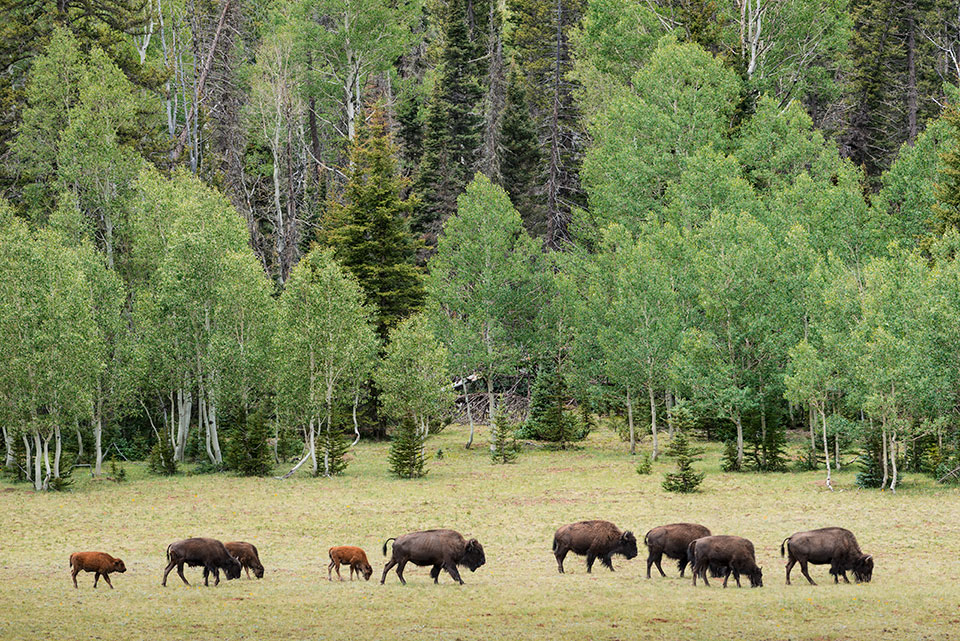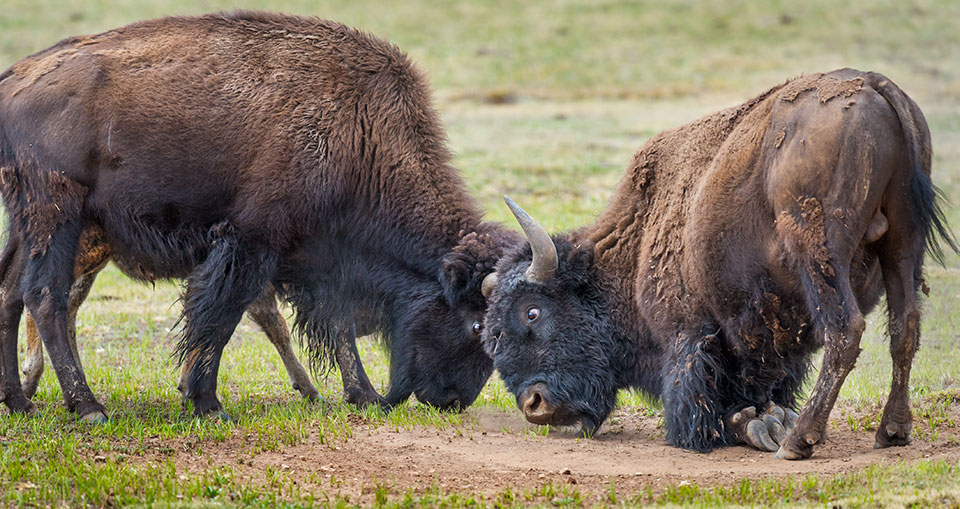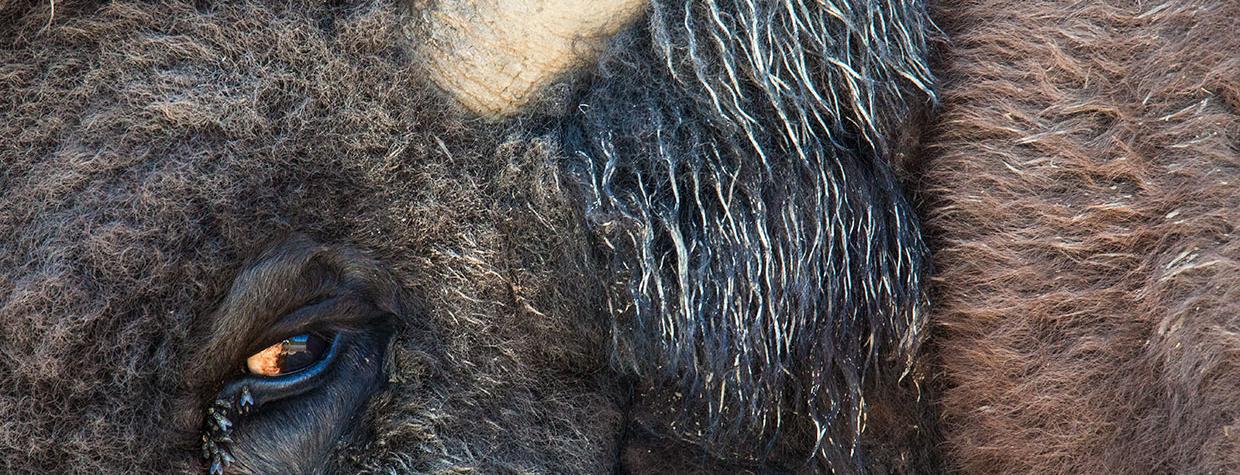When 30 million bison roamed the North American continent, some of them found their way to the Kaibab Plateau. Biologists believe they were present in small herds off and on over the past 11,000 years, and that this corner of Arizona formed the southwestern limit of their historical range. Bison stories and dances passed from generation to generation among the Kaibab-Paiute, Navajo, Hualapai, Havasupai, Yavapai-Apache and Hopi tribes seem proof enough of their existence here. The Arizona Bison Management Plan agrees, noting that the totality of the archaeological record, rock art and Indigenous tradition suggests bison were in Arizona.
Bison — or buffalo, the common (if incorrect) name I tend to use — were long gone by the time of Arizona’s Anglo settlement, which causes some people to doubt they were ever present. Such people say bison don’t belong here, that they wouldn’t be here if erstwhile bison hunter Charles Jesse “Buffalo” Jones hadn’t brought a bunch of them to the Kaibab in 1906. Jones thought he could build a cow that would survive blizzards like the one that had killed thousands of cattle on the Plains in 1886, and make a fortune in meat and hides besides. He brought captured bison calves to the Kaibab after persuading one big-game hunter, President Theodore Roosevelt, to allow his bison on that land. Roosevelt designated more than 600,000 acres of what then was the Grand Canyon Forest Reserve as a game preserve in 1906. And Jones set about crossing bison with Scottish Galloway cattle.
It didn’t work. Or it worked well enough to create generations of bison with cattle genes, but not well enough to build a viable business. When the business failed, Jones’ investors took what they could, while Jones himself headed to Africa to rope gorillas. Investor Jimmy Owens — Jones’ assistant when, years before, Jones was the Yellowstone National Park game warden — bought out the others and eventually sold the herd to Arizona, which is how it happened to arrive at House Rock Wildlife Area and, later, the North Rim of the Grand Canyon. The progeny of those animals look entirely like bison but carry some cattle genes. Nothing visible marks those genes’ presence, and Grand Canyon National Park notes that despite the presence of some cattle DNA, these animals’ physical features and behavior show that they are bison — not “beefalo” or “cattalo,” two commonly used terms for bison-cattle hybrids.

I once watched a lone bison bull move through a few isolated trees and across a broad meadow near the North Rim. If I hadn’t known about Jones’ debacle, I would never have thought the gorgeous, ancient animal before me was anything but pure bison. Nothing in particular happened as I watched. It was just there, in a landscape that suited it. There were no other bison around. There was nothing else around — just the bison, the trees, the meadow’s grass moving slightly in a light breeze. The bison and I existed in a hugeness of silence. It moved across the meadow, as bison have done since the ice age. It knew nothing about Buffalo Jones’ attempt to cross bison and cattle.
It was just this, silence and the lone bull, that reminded me of another experience of silence and a lone bull. Skiing in the silence of Yellowstone’s winter, I hadn’t seen another person all morning. When it was time for lunch, I looked for a comfortable boulder — few luxuries on Earth equal that of a good boulder to lean against. Spotting one a few yards away, topped with a layer of snow but with sides steep enough that they were bare of snow, with sun pouring onto the far side, I skied toward it. It got up and walked away. Bison, resting in the sun.
Bison evolved from the ice age’s steppe bison, an animal about the size of today’s bison but with much larger horns. (Personally, I feel that today’s horns are quite large enough.) The steppe bison’s ancestors evolved in the grasslands of Europe and Asia more than a million years ago. About 160,000 years ago, they crossed the land bridge from Asia to become the most abundant large herbivore on this continent. America’s Plains bison, evolving with the Great Plains, created an entire ecosystem.
Meanwhile, at the Grand Canyon, rather than benefitting the park environment as they once benefitted the Plains, bison have sparked concern that they trample pristine meadows, damage archaeological sites and pollute water sources (although bison wallows can become temporary water sources for other wildlife). Winter helicopter flyovers showing bison at the bottom of the Kaibab Limestone layer below the North Rim and at Powell Point raise concerns about damage to cultural features. It is possible, theoretically, to build bison-proof fences, but in 2017, when the park fenced off water sources, bison simply did what bison do: destroyed most of the fencing. They are very big. Bulls typically weigh between 1,000 and 2,200 pounds, cows between 800 and 1,200 pounds. They are also fast, with a running speed of about 35 mph.
Managing the Kaibab herd, one of the few unfenced wild herds in the country, is a shared endeavor. Grand Canyon National Park, the Arizona Game and Fish Department and the Kaibab National Forest take part in management, and the Canyon’s 11 traditionally affiliated tribes also have a hand in it. The North Rim bison wander out of the park and onto the national forest without recognizing boundaries, although they do seem aware they can’t generally be hunted on the North Rim. (Were they historically on the North Rim? Those records of small, occasional herds in the area of the Kaibab make no mention of it.)
Management involves keeping herds at numbers the land can handle; here, the park plans to reduce the herd to fewer than 200 by 2025. Much of the reduction is managed through live capture, after which the bison are transferred to the Intertribal Buffalo Council for transport to various tribes wishing to grow their own herds. “Lethal removal” by tribal members and skilled volunteers is also used. In 2021, the Park Service held a lottery to let 12 skilled shooters kill bison within park boundaries; during the 48 hours the application portal was open, 45,040 people applied for the 12 spots.
The state of Arizona considers bison wild big game. Annual hunts are held at the House Rock and Raymond wildlife areas, where genetically pure herds are managed by Game and Fish. The department also manages bison on the U.S. Forest Service land of the Kaibab. Hunters get one bison per lifetime. Reincarnation is not mentioned in the regulations.

Although the original bison at House Rock Wildlife Area were those that Arizona bought from Jimmy Owens, the animals currently there are genetically pure animals from the American Prairie Reserve in Montana. When I ask the wildlife area’s manager, Sam Pogue, if those bison ever try moving beyond their territory, he says that as long as they have food and water, they seem content on the land they have.
The Raymond Wildlife Area herd came from Wind Cave National Park in South Dakota, and they are descendants of bison captured by William Hornaday, the first director of the New York Zoological Gardens (now the Bronx Zoo). Hornaday brought them to New York City at a time when they had all but disappeared from the Plains. In 1905, he and Roosevelt created the American Bison Society to expand their numbers, and by 1913, the society had enough bison to restore free-ranging herds. Working with the Interior Department, the group donated 14 to Wind Cave, and now, more than a hundred years later, the Wind Cave bison have helped re-establish herds across the U.S. and Mexico, including in this corner of Arizona. Like the Yellowstone bison, these animals are free of cattle genes.
Yellowstone’s bison, too, have been vital in regrowing the herds that once covered the Plains. After most of those had been wiped out, 25 animals remained hidden in Yellowstone’s remote Pelican Valley. Their numbers were augmented in 1901, when Congress provided money to purchase 21 more from private owners and get them to Yellowstone. After being fed and monitored at the then-remote Lamar Buffalo Ranch (now the Yellowstone Forever Institute), they were finally freed to go and be bison. Ultimately, they mixed with the park’s free-ranging population, which has grown to the almost 5,000 roaming Yellowstone today. (Some of Yellowstone’s excess bison also go to the Intertribal Buffalo Council.)
My first bison experience was also my first visit to Yellowstone. Winter. I had driven a snowmobile to the Fountain Paint Pot, parked it and begun walking the half-mile loop boardwalk. I was almost at the end when a bison descended from a wooded rise onto the boardwalk, stopping a few feet in front of me. A bison a few feet away is very big. Walking in the snowmobile suits of that time was like walking on the moon. It was hard work. It was waddling. I did not want to walk all the way back. But there was a bison, standing square across the boardwalk, that seemed permanent. Stepping off the boardwalk would have put me into the thermal features. I turned around to waddle the almost half-mile back.
When, years later, I encountered one as I was driving across a bridge in Yellowstone, I knew what to do. It stood its ground, which covered most of the roadway. I backed off the bridge.
Bison are cousins to cattle and gaur but are most closely related to yaks. I rode a yak once in Mongolia — which was actually a gentle experience — but I am not interested in riding a bison. I met a man who did, though. He and his bison, Chief, trained while still a calf, performed at rodeos across the country, the two of them practically one being. “I’ve learned a lot from Chief,” the man told me. “Even as far as working horses. I think if people took the time to listen — they don’t take the time to learn — the buffalo is the teacher.”
Is the buffalo the teacher? I’m curious what lessons will come from those on the North Rim.

